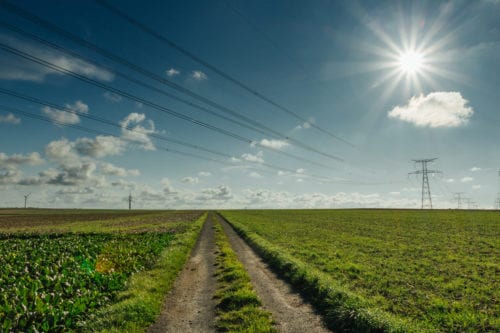Countryside landscape in the blue sky in Normandy, France. Electricity generation and distribution. Electric power industry and nature.

- Blog
- Electricity
- Electricity Reforms in India Can Deliver Economic, Social, and Climate Benefits
Electricity Reforms in India Can Deliver Economic, Social, and Climate Benefits
“Innovations rarely occur when everyone’s happy and safe, or when the future looks bright. They happen when people are a little panicked, worried, and when the consequences of not acting quickly are too painful to bear.” – Morgan Housel
The COVID-19 pandemic has substantially slowed the global economic engine, forcing nations to rethink their growth story. India is facing the brunt of this disruption as it confronts the sharpest GDP contraction among major Asian economies. However, the country can jumpstart its economy by designing a green recovery stimulus that could usher an era of clean economic growth. And electricity sector reforms could be the catalyst to drive such a cleaner and more sustainable economy.
Unfortunately, the pandemic is only an early insight into the far-reaching consequences of larger global challenges expected in the near future. Unchecked global warming will greatly disrupt livelihoods and economies, leaving a lasting negative impact to entire nation states.
Although India is in on track to realize its 2˚C compatible Paris Agreement climate targets a decade earlier than anticipated, a 2˚C warming of the planet would have devastating impacts on the country. The total number of severe heat waves are projected to increase by 400 percent and the exposure of the population to these heat waves increases by almost 500 percent compared with 1.5˚C warming by the end of the century. Some of the major agricultural states in the country are the most vulnerable to the impacts of climate change. Hence there is an undeniable need for the country help accelerate the global decarbonization movement to mitigate global warming to well below 2˚C.
Investing in Renewables
India’s historical contribution to global carbon emissions has been less than 5 percent to date, but is projected to rise as the population and economy expand. The electricity and heat generation sectors account for almost half of the country’s carbon emissions, and will largely drive future emissions. Fortunately, renewable power generation capacity is projected to rise from close to 40 percent today to almost 65 percent by 2030.
Beyond 2030, India can use renewable energy as a major driver to build a more sustainable, equitable, and inclusive economy while continuing to contribute towards 1.5˚C warming. A recent analysis by McKinsey specifies that an annual investment of USD$75 billion in renewable energy and climate change adaptation technologies could generate USD$90 billion in economic value and support 2 million jobs by 2030 in India.
A recent study by Centre for Policy Research suggests that electricity can be used as an instrument to build a resilient rural economy by replacing the current welfare-based electricity distribution with a scheme that empowers rural consumers to pay for better quality of service through the productive use of electricity. This approach can improve electricity access security and provide the infrastructure needed for rural industries and businesses to thrive, which is critical for post-pandemic economic recovery.
For example, installing 1 Megawatt of solar power in each of India’s 6 lakh villages would provide 600 GW of solar power just in the rural sector. Since DISCOMs provide free electricity for agriculture and lose around Rs 4–5 for every unit of electricity supplied to lower-income households, decentralized solar power would help reduce the cost of power supply while increasing reliability. Hence, such initiatives have significant benefits for DISCOMs, agricultural consumers, and low-income households. This initiative alone could meet more than 25 percent of India’s projected electricity demand by 2040.
Introducing similar interventions that help accelerate wind and hydro power deployment to their maximum potential can result in complete carbon independence for the country’s electricity sector. This can help India create a blueprint for larger nations to follow and mitigate global warming to 1.5˚C.
Benefits Beyond Climate and Economic Growth
Drafting a green recovery stimulus also delivers higher returns on government spending than a conventional stimulus in the short and long term. Reducing the reliance on fossil fuels helps reduce India’s huge trade deficit and the subsidy burden that amounted to US$10 billion in FY2019 alone.
A greener economy will also result in significant health benefits for India’s citizens. India’s power sector is largely responsible for particulate (PM2.5) air pollution in the form of almost 60 percent SO2 emissions and 25 percent NOx emissions. Particulate air pollution will remain the greatest risk to human health in India after COVID-19. Mitigating air pollution can increase life expectancy by almost ten years for the residents of the national capital alone.
Recent developments also suggest that renewable energy is becoming one of the cheapest source of electricity generation. Gujarat, Chhattisgarh, and Maharashtra have recently announced their intentions to discontinue building any new coal power plants. Coupling this initiative with an accelerated retirement of inefficient thermal assets can put India in a great position to expand its renewable energy capacity well beyond 2030.
The Need for Government Reforms
Half of all India’s carbon emissions today come from the industrial, transport, buildings, and agriculture sectors. And while a plethora of commercially viable carbon-free technologies already exist across these sectors, they require support in the form of government reforms to de-risk their initial deployment. Thus, to keep warming to below 1.5°C and avoid the most devastating impacts of climate change, there is an urgent need to update existing government reforms in the renewable energy sector.